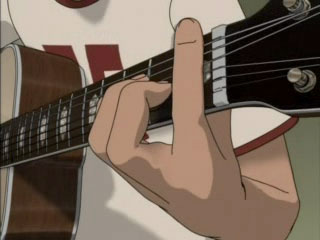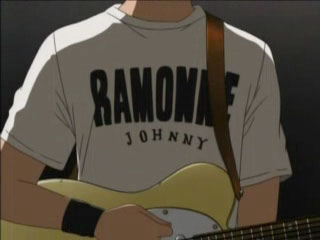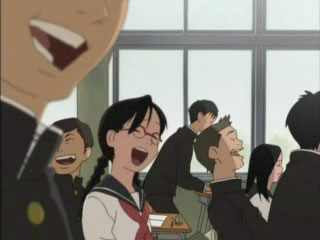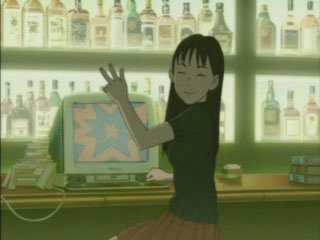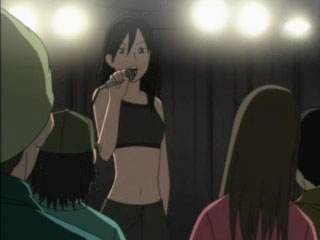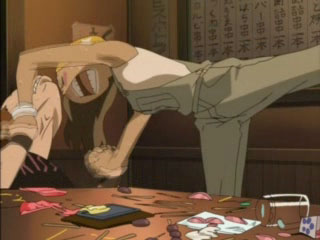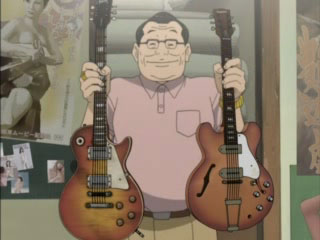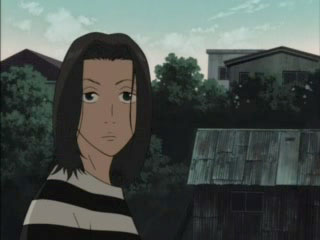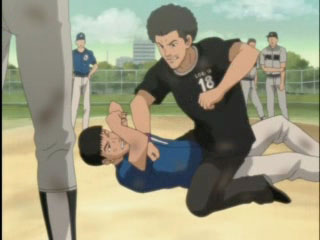 Logo handmade by Bannister
Column by Scott Green
Logo handmade by Bannister
Column by Scott Green

Anime Spotlight: Beck - Mongolian Chop Squad Volume 1 Released by FUNimation
The first volume of rock anime Beck: Mongolian Chop Squad opens with a five episode block that could be thought of as a stand alone, if very opened ended, short story. While the series is worth the attention of anime fans, if you're not a regular anime consumer, still do yourself a favor by renting this DVD. Anime proponents generally start getting insistent like that about works that are transcendent, classic or important, as when talking about features like Hayao Miyazaki's, Satoshi Kon's or Grave of the Fireflies. Rather than pursuing lofty objectives, Beck offers an exuberant, fun story of a newcomer learning to love rock. As cliche as the assertion sounds, though there are no explosions and the extent of the action is a baseball game brawl and a few drunken punches, it's forceful personality and dynamic expressiveness make Beck one of the most exciting entries into the current slate of anime releases. Beck strikes with the guitars early. Its opening sequence captures young Japanese rockers cruising a photorealistic modeled re-creation of the South West, driving past cheap motels and ministry sign boards (an Assembly of God "Pray - or You Will Become Prey"), and rubbing shoulders with characters from road side diners. Set to Beat Crusader's "Hit in the USA," the sequence pipes in the American aesthetic as a banner of individual expression. Even if the story of a teenage boy discovering his passion and ability to pursue a chosen endeavor is traveling a familiar trajectory, the presentation is sufficiently energized that Beck becomes something special, thanks to the personal vitality of its characters and the creative force of the work itself. From the starting point of a manga by Harold Sakuishi, an artist whose eclectic tastes include a passion for the Red Hot Chili Peppers, innovative director Osamu Kobayashi turns in an anime as with a unique look, tailored for its characters and situations.The early phase of the anime is told through a pair of intersecting stories. It opens with a glance into the dreary existence of the Koyuki, a polite early-teenager. He's uninspired by scholastic life. His closest friend is a frivolous twit. He hasn't been motivated to latch onto an extracurricular activity. Though he demonstrates that he is far from spineless, his default approach is particularly unassertive. After a day of drifting through school and being put into uncomfortable situations by his friend, Koyuki collapses onto a sideway bench. When he sees a group of children torturing a dog, his "do the right thing" impulses kick in, and he chases the youngsters off. This very strange and very unfriendly (at least to Koyuki) patchwork coated dog is the eponymous Beck, and he belongs to Ryuusuke, a talented rocker who grew up in the US and is now spending his time in Japan trying to put together a band that lives up to his standards. Ryuusuke used to play with the lead guitarist for the successful band Dying Breed, and through that band's music Koyuki's childhood friend Izumi introduces him to the thrill of rock music. On a conversational level, neither Koyuki or Ryuusuke are loud or vocal, but there is an interesting, stressed friendship developing between the two foils. Not only do Ryuusuke's American mannerisms set him apart from Koyuki's frequently Japanese attitudes, his self satisfied guru's confidence is both a draw and a challenge to the generally uncertain Koyuki. The drama between them taps into the divide between the hard working every-person and the consummate artist. Though Ryuusuke is cool and charismatic, and by extension of Koyuki's thoughts, the anime puts a high value on his opinion, Ryuusuke is a fascinatingly multi-dimensional character. His positive image does not hide all of his unpleasantness. There is an edge of the hard to live with genius that especially becomes an issue when his calmness gives way to coldness. With the icy habit of tossing out girls when he is no longer interested in their company, this isn't entirely a pleasant character. The first set of episodes bounces between Koyuki's struggling to pick up the basic skills needed to be a credible rock musician and Ryuusuke tussling with rivals to put together a band. Anyone alert during the opening credits knows the outcome of this early phase. For example, the competition over a particularly talented punk bassist is especially predictable, though the results probably would have been obvious even if the guy wasn't shown with, Ryuusuke and Ryuusuke's new vocalist in the opening credits. Still, there are a number of interesting developments. Koyuki finds an amusingly unique mentor in Saitou, a squat middle aged man who spends his days being emotionally and financially beat up in the paper business, and his evenings demonstrating his demonic vigor in the pool (he was once an Olympic swimmer) or picking up his guitar to emulate his favorite band, Beatles stand-ins, the Rocket Boys. There is also a love triangle in the works between Koyuki, Izumi and Ryuusuke's younger sister Maho. That thread is early in its development, but the tone already suggests that the characters will be smart about it, and avoid the typical histrionics. There are definite parallels here to the "I'll be the greatest[pirate, ninja, ect]!!!" of adventure stories as well as the sports serials. Anime does construct compelling adventures around this well "I will overcome obstacle X" storytelling. Though Beck similarly encourages the viewer to invest in its lead's progressional success, the anime is ultimately less formula bound and more naturalistic. The anime establishes the characters' personalities well enough that it can rely on the viewer to sympathize with their motivations. Because they are convincing, and because their situation is credible, but also enviable and exciting, the anime does not need to spend time establishing challenges or using manufactured obstacles as steps. That allows a more nonlinear story, that circles back or springs opportunities and one whose achievements are personal, rather than contrived or artificial. As much as Beck is a vicarious experience, in which one can get a secondhand buzz from the mood of trials and success, the anime allows the viewer to appreciate just sitting in on the characters' conversations. The attraction is watching the set of characters and not just the destination or even the process. Details are accentuated rather than the human interest route of American Idol musician histories. The anime series might be full of the unusual, but it is guarded in its use of the extraordinary. There is no sob stories or "X happened, therefore Koyuki became a musician". Though a few memorable events and confrontations occur in the first episode , they are largely incidental to the accumulation of smaller nudges the turn Koyuki onto music. Despite the presence of eccentric characters like Saitou, Beck is not given to sensationalism. No one is screaming about their problems or even going out of their way to explain them. At the same time, the characters are not deflated to the point where there are no significant details beyond what appears onscreen. The suggestion remains that there are some matters that are kept private from the viewer. For example, Koyuki's mother is treated as an unseen presence who is always in a separate room from the character, and generally on the phone laughing. The details of this relationship, or why the character seems to have noticeably less pocket money than his peers are kept out of the dialog. Allowing concerns that don't directly effect the main story to exist without direct comment is rather atypical for anime, and understanding that not everything that has a bearing needs to be discussed openly is a notably sophisticated approach to handling characters. A substantial factor in what makes Beck's characters compelling to watch is the work of director Osamu Kobayashi. The series looks like it fits into a progression from Gad Guard at Gonzo (an underrated mecha series that plays like a novel or extended indie movie) to Beck and later Paradise Kiss at Madhouse, in which Kobayashi adds a degree of elasticity to the animation to reflects the energy of his young subjects. The approach is situated in a deeply detailed context. Rather than an emphasis on architecture, streets and the designs of civil engineer, the emphasis is on the human component: clutter, billboards, posters and spots settled in use. People and crowds don't just seemed inserted into these backdrops. Characters similarly benefit from an approach that is both relaxed and precise. A great deal of thought seems to have been put into capturing the right look for every careless posture, swerving body in a concert crowd, and inebriated bar patron. Kobayashi knows when to loosen the design model, and allow the shape to fall or twist into imperfection. At the same time, the anime looks like it is cleverly managing its anime budget. The strength of its expressiveness allows it to artfully situate a large, static character in the foreground of a long shot without hammering the impression of a shortcut. In other cases simple design and motion are kept interesting through framing, such as seeing a confrontation through an ajar door, or by knowingly directed pans and cuts. Alternately, great effort might be given to the motion of small details, such as the wind, or the fit and wrinkles on a shirt as its wearer moves. An example of how this animation approach works is a case where Koyuki travels across the city to meet Izumi. Standing in a busy street, under a tangle of utility wires and surrounded by a buzz of passing people, he sees Izumi in the window of a cafe above street level. He stops moving, and spends a long minute looking at her legs. As Koyuki's face undergoes the shift from a subtle blush to faint pleasure, the image is positioned behind one of those static frames: an intensely indifferent, scowling young woman. Koyuki had previously objected to his friend spying on swimming girls, but in this case he's too far away from the girl for the moment really to be prevy. The situation is amusing without being a joke. This might not be terribly spectacular or significant, but it is a nice, breathing moment captured through anime that is a joy to watch. The anime's music fits its role. So far, nothing was supposed to be spectacular, so only the opening and end themes are really iPod worthy. The rest sounds credible and in some cases rather good, but, in keeping with the plot, nothing to set the world on fire. The spinets of Dying Breed that grab Koyuki's attention are a bit like generic guitar music, but that they capture his imagination could say more about the character than the music. Even in that case the anime allows the viewer to decide how they feel about the music. Nothing is unduly exaggerated. For example, when a band flubs a gigs, factoring in the technical problems, the performance is empty and problematic, but not a terrible disaster. Even setting aside the singing concerns, the anime was evidently a challenging work to localize. The characters are keenly aware that they are balancing between two cultures and in some cases, two languages. This is maintained in the translations. Both the English audio dub and the subtitle scripts maintain the hamburger versus stir fry discussions, and even keep a teacher's odd lecture about the history of American pro-wrestling. When vocal language gaps crop up in the dialog, the dub script (which is different from the subtitles) gracefully skips over it. That doesn't sound good on paper and the gesticulations involved in a interaction between two people not speaking the same language does look odd when presented in one language. Ultimately, this solution is awkward, and it leaves no doubt that something had been changed in the localization but it might be the best of a field of non-ideal options. At least it has the benefit of not taking the watcher out of the anime. The casting for Koyuki might have been another case where it was impossible to deliver on the absolute ideal. In the Japanese recording, Daisuke Namikawa was cast for the character. Namikawa is a versatile actor whose work includes a host of everyman protagonists including Rock in Black Lagoon, Suzuo in Dokkoida, and Kei Kurono in Gantz, as well as a selection of calm, quiet guys, such as Fay in Tsubasa, Teen in Tide-Line Blue and Eks in The Third. He was also Anakin Skywalker in the Japanese dubs of episodes 2 and 3. However, Husking Bee's Kazuya Hirabayashi performed the characters vocals. In the English language recording, Greg Ayres voices the character in speech and song. The singing in the English dub leaves no question of the talent of the voice performers. These episodes probably do not test them as much as later ones will, but, so far, they sound perfect for their roles. The issue is that Ayres brings something to his characters and that that quality suggests something different about Koyuki. Ayres is very good at the squeaky characters, such as Chrono in Chrono Trigger, Shinji Kazama (the geeky classmate) in Full Metal Panic, Negi in Negama, Goku in Saiyuki. He has shown range in his anime work and played degrees against that type, but, fans of his cuter roles may find more to appreciate in his take on Beck's lead. Maybe this will change as the character develops, but Ayres's Koyuki of these early episodes sounds brittle. The suggestion isn't just that Koyuki's unexcited and generally disinclined to assert himself, it's that the character is actively weak. Rather than a slightly quiet regular guy who is the one person in the crowd who will calm his jitters and stand up when the situation calls for it, he's the guy that should watch out for a stiff wind when he does decide to show spine. What the actor does best is a few degrees off from what the character needs. It's like casting Christopher Walken for a William H Macy role. Then again, Daisuke Namikawa has his trouble with the character, beyond the singing. Ayres's portrayal of the character when he's comfortable and loudly excited is a bit more credible than Namikawa's. The English dub's Saitou fits the tone of the anime slightly more than the Japanese track's. Where Porche OKite's Saitou is something out of a comedy routine, R Bruce Elliott (Kambei in Samurai 7) seems more like a memorable, eternal bachelor. Saitou's talking parrot Page is obnoxious in both. He's sounds gratingly like a gremlin in the English and like a vulgar Pokemon in the Japanese. Neither is particularly fits with the series' general realism. Though Beck does not conform to the expectations of one of the popular genres or feature shoot-ups or other traditionally exciting elements, it is not an 'eat your broccoli' title. Osamu Kobayashi's animation along with the dynamic between characters like Koyuki and Ryuusuke is unarguably vigorous. They might not be gearing up for some fight or competition, but but their story is still thrilling.

